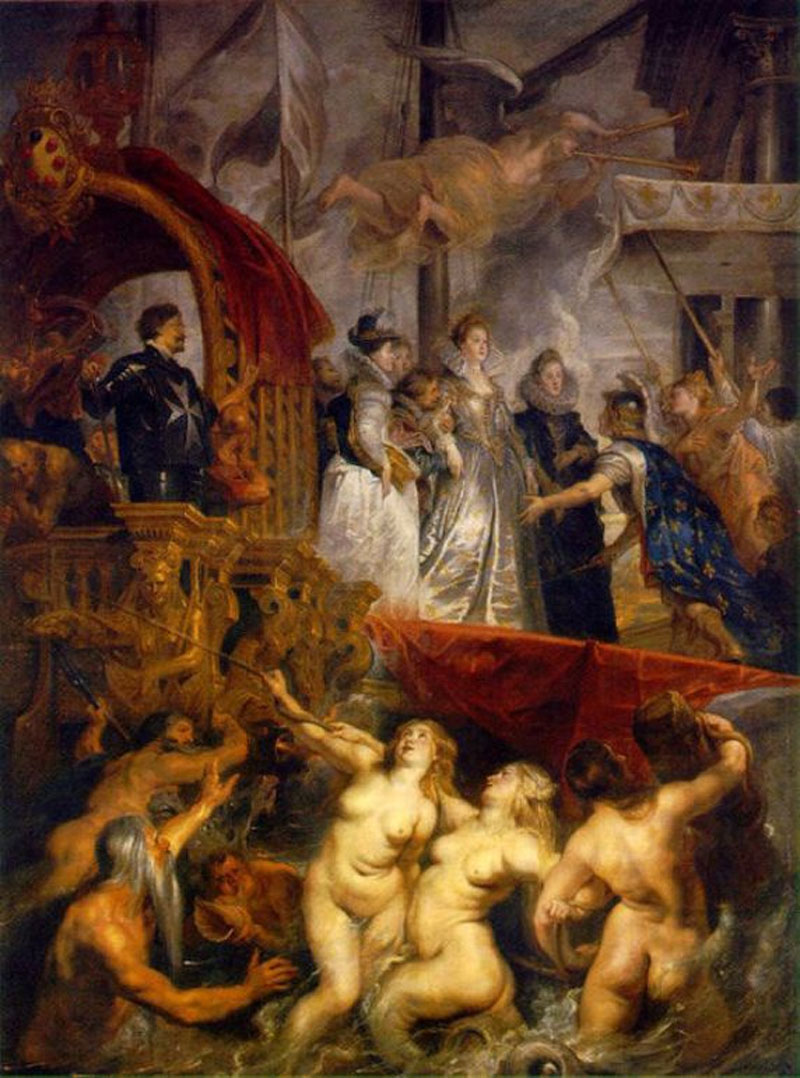
Arrival of Marie de Medici at Marseilles, Peter Paul Rubens
Depicted people
Marie de' Medici
Eleanor de' Medici
Neptune
circa 1622-1625
oil on canvas
Height: 394 cm (12.9 ft); Width: 295 cm (116.1 in)
Collection
Louvre Museum
Department of Paintings of the Louvre
France
Accession number
INV 1774 (Department of Paintings of the Louvre)
References
described at URL: https://www.wga.hu/html/r/rubens/40histor/02medici.html E
described at URL: https://www.wga.hu/html/r/rubens/40histor/01medici.html
Joconde database: entry 000PE008770
Musée du Louvre, Atlas database: entry 25626
RKDimages, Art-work number 60919.
The Arrival of Marie de Medici at Marseilles is a c. 1622-1625 Baroque painting done by Sir Peter Paul Rubens. It was commissioned by Marie de' Medici of France to commemorate the life of her and her husband Henry IV of France. This painting was one of the 24 paintings in the Marie de' Medici cycle by Rubens.[1] The painting currently resides in the Louvre in Paris. [2]
History
Marie de Medici commissioned 24 paintings, pictures that depicted historical events in her life, with the intention to decorate the Palais du Luxembourg. She commissioned the paintings in an attempt to sway public opinion regarding her right to rule. Due to her foreign heritage, the French saw her as undeserving of her position as a ruler. After her arrival, she married Henry IV in 1600. He would die ten years later, well before the cycle was commissioned.[3]
Description
The Arrival of Marie de’ Medici at Marseilles shows the Queen of France arriving by ship in Marseille on November 3, 1600. She is greeted by unknown characters that represent France, as they are seen with the French royalty symbol, the Fleur-de-lis. At the bottom of the painting, Neptune and the daughters of Nereus, the Sea God, are seen saluting the Queen. At the top of the painting, the character Fame is flying overhead, trumpeting the Queen’s arrival. Rubens uses these symbolic figures to transform a historical event into an allegory that reinforces Marie de' Medici's right to the throne. The various French symbols depicted greeting Marie upon her arrival are meant to establish good will and respect between her and the French people.[4]
References
Adeline, C. (n.d.). Work The Apotheosis of Henri IV and the Proclamation of the Regency of Marie de Médicis. Retrieved April 11, 2019, from https://www.louvre.fr/en/oeuvre-notices/apotheosis-henri-iv-and-proclamation-regency-marie-de-medicis
Kren, E., & Marx, D. (1996). The Landing of Marie de Médicis at Marseilles. Retrieved April 9, 2019, from https://www.wga.hu/html_m/r/rubens/40histor/01medici.html
Kraftner, Johann. Peter Paul Rubens: 1577-1640. Thames & Hudson, 2005
Green, J. D. (2009, August 11). Arrival of Marie de’ Medici at Marseilles. Retrieved March 13, 2019, from https://contentdm.lib.byu.edu/digital/collection/Civilization/id/880/
----
Ankunft von Marie de Medici in Marseille, Peter Paul Rubens
---
Άφιξη της Μαρίας των Μεδίκων στη Μασσαλία. Πέτερ Πάουλ Ρούμπενς
---
Fine Art Prints | Greeting Cards | Phone Cases | Lifestyle | Face Masks | Men's , Women' Apparel | Home Decor | jigsaw puzzles | Notebooks | Tapestries | ...
---


